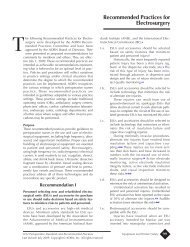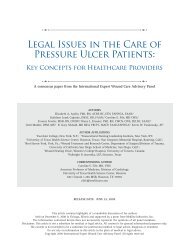2009 CAUTI guidelines - Centers for Disease Control and Prevention
2009 CAUTI guidelines - Centers for Disease Control and Prevention
2009 CAUTI guidelines - Centers for Disease Control and Prevention
You also want an ePaper? Increase the reach of your titles
YUMPU automatically turns print PDFs into web optimized ePapers that Google loves.
acteriuria inevitably occurs over time either via breaks in the sterile system or via theextraluminal route. 24 The daily risk of bacteriuria with catheterization is 3% to 10%, 25,26approaching 100% after 30 days, which is considered the delineation between short <strong>and</strong> longtermcatheterization. 27Formation of biofilms by urinary pathogens on the surface of the catheter <strong>and</strong> drainage systemoccurs universally with prolonged duration of catheterization. 28 Over time, the urinary catheterbecomes colonized with microorganisms living in a sessile state within the biofilm, renderingthem resistant to antimicrobials <strong>and</strong> host defenses <strong>and</strong> virtually impossible to eradicate withoutremoving the catheter. The role of bacteria within biofilms in the pathogenesis of <strong>CAUTI</strong> isunknown <strong>and</strong> is an area requiring further research.The most frequent pathogens associated with <strong>CAUTI</strong> (combining both ASB <strong>and</strong> SUTI) inhospitals reporting to NHSN between 2006-2007 were Escherichia coli (21.4%) <strong>and</strong> C<strong>and</strong>idaspp (21.0%), followed by Enterococcus spp (14.9%), Pseudomonas aeruginosa (10.0%),Klebsiella pneumoniae (7.7%), <strong>and</strong> Enterobacter spp (4.1%). A smaller proportion was causedby other gram-negative bacteria <strong>and</strong> Staphylococcus spp 5 .Antimicrobial resistance among urinary pathogens is an ever increasing problem. About aquarter of E. coli isolates <strong>and</strong> one third of P. aeruginosa isolates from <strong>CAUTI</strong> cases werefluoroquinolone-resistant. Resistance of gram-negative pathogens to other agents, includingthird-generation cephalosporins <strong>and</strong> carbapenems, was also substantial 5 . The proportion o<strong>for</strong>ganisms that were multidrug-resistant, defined by non-susceptibility to all agents in 4 classes,was 4% of P. aeruginosa, 9% of K. pneumoniae, <strong>and</strong> 21% of Acinetobacter baumannii. 2924
















